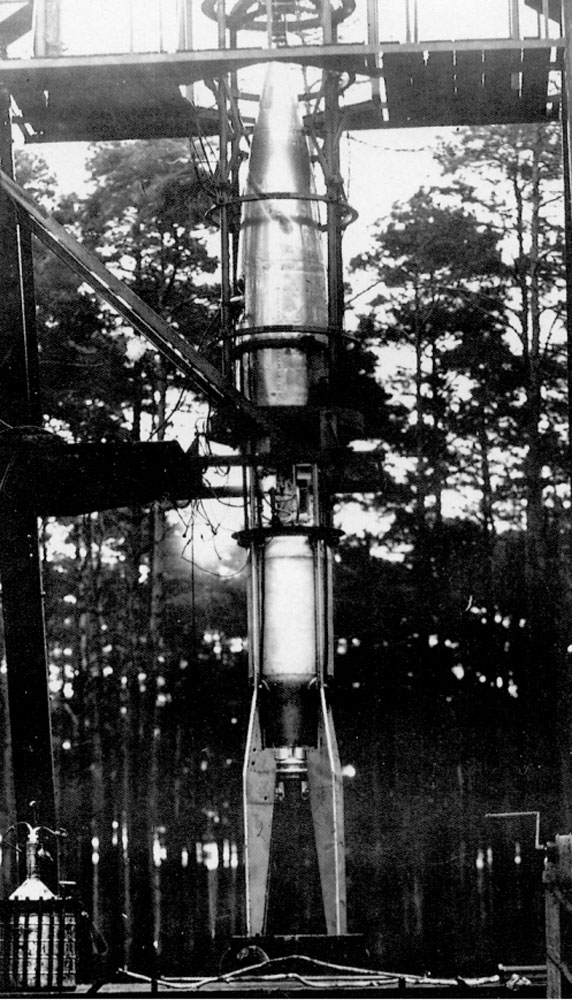
An A-3 rocket mounted at Kummersdorf on stand no. 3. This was the largest at Kummersdorf and could be moved along the rails that can be seen in the photograph.
The chief of the Army Ordnance Bureau (the Heereswaffenamt), Colonel Carl Becker, was an expert on ballistics. In 1926 he had drafted a short paragraph on military rockets for the Army Textbook of Ballistics and in 1929 he issued instructions to contact any amateur rocket societies whose enthusiasts might have useful insights into how rockets could perhaps be developed. Becker was aware that rockets had not been referred to in the Treaty of Versailles, and he knew that there could be no restriction on further research into this potentially important area of ballistics. In the following year, Captain (later Major-General) Walter Dornberger joined Becker’s office to start work on a possible new solid-fuel rocket with a range of up to 5 miles (8km).
Bureaucracy was quick to play a part. It was decided that the proposals for solid-fuel rockets could best be advanced if there was an official development and testing facility, and the result was the establishment of the Army Ordnance Bureau’s Research and Development Department (the Heereswaffenamt-Prufwesen, conveniently known for short as the Wa Prüf) at Versuchsstelle Kummersdorf-West. This would become a development laboratory and a testing site for missiles.
Public protests about the noise and danger from the test firings at Kummersdorf meant there was a clear need for a new facility, well away from large populations and with plenty of space for testing larger rockets. In 1935 the decision was taken to find a new, remote location and enquiries began. During the Christmas holidays that followed, Von Braun accepted an invitation to spend some time with friends near the coast of the Baltic Sea. They lived at Anklam, between Stettin and Straslund, by the Peene River. There was an island named Usedom nearby, with just a few inhabitants living on an isolated, rural existence; the Baltic island of Greifswalder Oie lay on the horizon, and beyond that stretched the open Baltic — it was the perfect location for a rocket base. Von Braun reported back to Dornberger, who asked for more details and later went to inspect the area personally. It was quickly resolved to transfer the research to this new base at the mouth of the Peene River – in German, Peenemünde.
By April 1937 the rocket organization was relocated to its new top-secret base at Peenemünde. This was destined to become the birthplace of modern rocketry, and since 1992 it has been part of the Military Research Centre (Heeresversuchsanstalt Peenemünde) an Anchor Point of the European Route of Industrial Heritage. The staff at the Army Experimental Station at Peenemünde (Heeresversuchsstelle Peenemünde) set out to improve upon the successful A-2 rocket and design a successor, the A-3. The result was a 1,6501b (750kg), 21ft (7m) long rocket burning liquid oxygen and alcohol fuel. By the end of 1937 the Peenemünde team had developed and were ready to test the prototypes. The first failed, and so did the test launches that followed. To the engineers it was obvious that the urgent rush to launch had been too swift. Early problems with the rocket had shown that the tail fins needed to be redesigned; and even when this had been done new problems were emerging. The propulsion system of the A-3 was a success but its inertial guidance system still did not function correctly and further work was initiated to solve this technical problem.
A new approach was needed – in future, every aspect would be bench tested separately and proved to work, prior to being incorporated into the final design. And so a revised policy was drawn up, in the remote vastness of Peenemünde. The German researchers laid their plans, confident that their secret location gave them the chance to make progress, away from prying eyes.